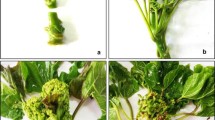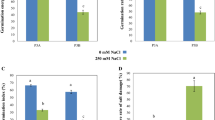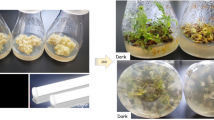Abstract
Main conclusion
In general, genes promoting IAA, CTK GA and ethylene biosynthesis were upregulated, while genes participating in ABA, chlorophyll and starch biosynthesis pathways performed opposite tendency during etiolation.
Abstract
Etiolation as a method for rejuvenation plays an important role in the vegetative propagation of woody plants. However, the molecular mechanism of etiolated shoot development remains unclear. In this study, we investigated changes at different etiolation stages of Juglans regia. The histology and transcriptome of J. regia were analysed using etiolated stems, which were treated in darkness for 30, 60, 90 days. The results showed that the ratios of pith (Pi) diameter/stem diameter (D), cortex (Co) width/D, and phloem (Ph) width/D increased, while the ratio of xylem (Xy) width/D decreased after etiolation, and the difference in these ratios between etiolated stems and the control was more significant at 60 days than 90 days. Differentially expressed genes (DEGs) were significantly enriched in pathways such as plant hormone biosynthesis and signal transduction, chlorophyll biosynthesis and degradation, and starch and sucrose metabolism. The difference in the contents of indole-3-acetic acid (IAA), abscisic acid (ABA), sugar and chlorophyll between etiolated stems and the control increased with increasing treatment duration; in contrast, the concentrations of gibberellin (GA), zeatin (ZT), and starch, as well as the difference between the etiolated stems and control were lowest at 60 days among the three stages. On the whole, the positive effect of etiolation on the rejuvenation of walnut stems changed as the treatment period increased. The present investigation lays a foundation for future studies on the effect of etiolation on rejuvenation and for promoting the efficiency of vegetative propagation.
















Similar content being viewed by others
Abbreviations
- DEGs:
-
Differentially expressed genes
- PIN:
-
Pin-formed
- GAox:
-
GA-oxidase
- CKX:
-
Cytokinin dehydrogenase
- NCED:
-
9-Cis-Epoxycarotenoid dioxygenase
- CTK:
-
Cytokinin
References
Achard P, Liao L, Jiang C, Desnos T, Bartlett J, Fu X, Harberd NP (2007) DELLAs contribute to plant photomorphogenesis. Plant Physiol 143:1163–1172
Achim G, Botu I (2001) Results in walnut propagation using different methods. Acta Hortic 544:503–509
Agrawal AA, Kearney EE, Hastings AP, Ramsey TE (2012) Attenuation of the jasmonate burst, plant defensive traits, and resistance to specialist monarch caterpillars on shaded common milkweed (Asclepias syriaca). J Chem Ecol 38:893–901
Agulló-Antón MA, Sánchez-Bravo J, Acosta M, Druege U (2011) Auxins or sugars: what makes the difference in the adventitious rooting of stored carnation cuttings? J Plant Growth Regul 30:100–113
Andrés H, Fernández B, Rodríguez R, Rodríguez A (2002) Phytohormone contents in Corylus avellana and their relationship to age and other developmental processes. Plant Cell Tiss Org 70:173–180
Bae G, Choi G (2008) Decoding of light signals by plant phytochromes and their interacting proteins. Annu Rev Plant Biol 59:281–311
Bagherabadi MM, Krens FA, Visser RGF, De Klerk GJM (2017) Etiolation and flooding of donor plants enhance the capability of Arabidopsis explants to root. Plant Cell Tiss Org 130:531–541
Barbez E, Kubeš M, Rolčík J, Béziat C, Pěnčík A, Wang BJ et al (2012) A novel putative auxin carrier family regulates intracellular auxin homeostasis in plants. Nature 485:119–122
Basheer-Salimia R, Patakas A, Noitsakis V, Bosabalidis A, Vasilakakis M (2005) Changes of morphological and physiological markers induced by growth phases in leaves olive tree (Olea europaea L). J Biol Res 2:105–114
Blilou I, Xu J, Wildwater M, Willemsen V, Paponov I, Friml J, Heidstra R, Aida M, Palme K, Scheres B (2005) The PIN auxin efflux facilitator network controls growth and patterning in Arabidopsis roots. Nature 433:39–44
Bond WJ, Midgley JJ (2001) Ecology of sprouting in woody plants: the persistence niche. Trends Ecol Evol 16:45–51
Carabelli M, Possenti M, Sessa G, Ciolfi A, Sassi M, Morelli G, Ruberti I (2007) Canopy shade causes a rapid and transient arrest in leaf development through auxin-induced cytokinin oxidase activity. Genes Dev 21:1863–1868
Cerrudo I, Keller MM, Cargnel MD, Demkura PV, de Wit M, Patitucci MS, Pierik R, Pieterse CMJ, Ballaré CL (2012) Low red/far-red ratios reduce Arabidopsis resistance to Botrytis cinerea and jasmonate responses via a COI1-JAZ10-dependent, salicylic acid-independent mechanism. Plant Physiol 158:2042–2052
de Wit M, Spoel SH, Sanchez-Perez GF, Gommers CMM, Pieterse CMJ, Voesenek LACJ, Pierik R (2013) Perception of low red:far-red ratio compromises both salicylic acid- and jasmonic acid-dependent pathogen defences in Arabidopsis. Plant J 75:90–103
Dubois M, Van den Broeck L, Inzé D (2018) The pivotal role of ethylene in plant growth. Trends Plant Sci 23:311–323
Fernández-Ocaña A, García-López MC, Jiménez-Ruiz J, Saniger L, Macías D, Navarro F, Oya R, Belaj A, de la Rosa R, Corpas FJ, Barroso JB, Luque F (2010) Identification of a gene involved in the juvenile-to-adult transition (JAT) in cultivated olive trees. Tree Genet Genomes 6:891–903
Fouda RA (1996) Anatomical characteristics of juvenile and adult shoots associated with rooting ability of Cupressocyparis leylandii cuttings. Kert Tud 28:107–111
Han F, Zhu B (2011) Evolutionary analysis of three gibberellin oxidase genes in rice, Arabidopsis, and soybean. Gene 473:23–35
Hartmann HT, Kester DE, Davies FT, Geneve RL (2011) Hartmann and Kester’s plant propagation principles and practices. Prentice Hall, Boston
Hisamatsu T, King RW, Helliwell CA, Koshioka M (2005) The involvement of gibberellin 20-oxidase genes in phytochrome-regulated petiole elongation of Arabidopsis. Plant Physiol 138:1106–1116
Huang LC, Chow TY, Tseng TC, Kuo CI, Liu SM, Ngoh MG, Murashige T, Huang HJ (2003) Association of mitochondrial plasmids with rejuvenation of the coastal redwood, Sequoia sempervirens (D. Don) Endl. Bot Bull Acad Sin 44:25–30
Huang LC, Hsiao LJ, Pu SY, Kuo CI, Huang BL, Tseng TC, Huang HJ, Chen YT (2012) DNA methylation and genome rearrangement characteristics of phase change in cultured shoots of Sequoia sempervirens. Physiol Plant 145:360–368
Husen A (2011) Rejuvenation and adventitious rooting in coppice-shoot cuttings of Tectona grandis. Am J Plant Sci 2:370–374
Husen A, Pal M (2006) Variation in shoot anatomy and rooting behaviour of stem cuttings in relation to age of donor plants in teak (Tectona grandisLinn. f.). New Forest 31:57–73
Hwang I, Sheen J, Müller B (2012) Cytokinin signaling networks. Annu Rev Plant Biol 63:353–380
Ju YQ, Feng L, Wu JY, Ye YJ, Zheng TC, Cai M, Cheng TG, Wang J, Zhang QX, Pa HT (2018) Transcriptome analysis of the genes regulating phytohormone and cellular patterning in Lagerstroemia plant architecture. Sci Rep 8:15162
Keuskamp DH, Pollmann S, Voesenek LACJ, Peeters AJM, Pierik R (2010) Auxin transport through PIN-FORMED 3 (PIN3) controls shade avoidance and fitness during competition. Proc Natl Acad Sci USA 107:22740–22744
Kim D, Langmead B, Salzberg SL (2015) HISAT: a fast spliced aligner with low memory requirements. Nat Methods 12:357–360
Kozuka T, Kobayashi J, Horiguchi G, Demura T, Sakakibara H, Tsukaya H, Nagatani A (2010) Involvement of auxin and brassinosteroid in the regulation of petiole elongation under the shade. Plant Physiol 153:1608–1618
Kuroha T, Tokunaga H, Kojima M, Ueda N, Ishida T, Nagawa S, Fukuda H, Sugimoto K, Sakakibara H (2009) Functional analyses of LONELY GUY cytokinin-activating enzymes reveal the importance of the direct activation pathway in Arabidopsis. Plant Cell 21:3152–3169
Lau OS, Deng XW (2010) Plant hormone signaling lightens up: integrators of light and hormones. Curr Opin Plant Biol 13:571–577
Li QF, He JX (2016) BZR1 interacts with HY5 to mediate brassinosteroid-and light-regulated cotyledon opening in Arabidopsis in darkness. Mol Plant 9:113–125
Liu H, Gao Y, Song XB, Ma QG, Zhang JP, Pei D (2018) A novel rejuvenation approach to induce endohormones and improve rhizogenesis in mature Juglans tree. Plant Methods 14:13
Livak KJ, Schmittgen TD (2001) Analysis of relative gene expression data using real-time quantitative PCR and the 2−ΔΔCt method. Methods 25:402–408
Li L, Ljung K, Breton G, Schmitz RJ, Pruneda-Paz J, Cowing-Zitron C, Cole BJ, Ivans LJ, Pedmale UV, Jung HS et al (2012) Linking photoreceptor excitation to changes in plant architecture. Genes Dev 26:785–790
Lumba S, Tsuchiya Y, Delmas F, Hezky J, Provart NJ, Lu QS, McCourt P, Gazzarrini S (2012) The embryonic leaf identity gene FUSCA3 regulates vegetative phase transitions by negatively modulating ethylene-regulated gene expression in Arabidopsis. BMC Biol 10:8. https://doi.org/10.1186/1741-7007-10-8
Lu N, Dai L, Luo ZJ, Wang SM, Wen YZ, Duan HJ, Hou RX, Sun YH, Li Y (2017) Characterization of the transcriptome and gene expression of tetraploid black locust cuttings in response to etiolation. Genes 8:345
Martínez-García PJ, Crepeau MW, Puiu D, Gonzalez-Ibeas D et al (2016) The walnut (Juglans regia) genome sequence reveals diversity in genes coding for the biosynthesis of nonstructural polyphenols. Plant J 87:507–532
Materán ME, Fernández M, Valenzuela S, Sáez K, Seemann P, Sánchez-Olate M, Ríos D (2009) Abscisic acid and 3-indolacetic acid levels during the reinvigoration process of Pinus radiata D. Don adult material. Plant Growth Regul 59:171–177
Matsoukas IG, Massiah AJ, Thomas B (2013) Starch metabolism and antiflorigenic signals modulate the juvenile-to-adult phase transition in Arabidopsis. Plant Cell Environ 36:1802–1811
Maynard BK, Bassuk NL (1996) Effects of stock plant etiolation, shading, banding, and shoot development on histology and cutting propagation of Carpinus betulus L. fastigiata. J Am Soc Hortic Sci 121:853–860
Meier AR, Saunders MR, Michler CH (2012) Epicormic buds in trees: a review of bud establishment, development and dormancy release. Tree Physiol 32:565–584
Menzies MI, Faulds T, Holden DG, Kumar S, Klomp BK (2004) Maturation status and genetic improvement effects on growth, form, and wood properties of Pinus radiata cuttings up to age 12 years. N Z J Forest Sci 34:255–271
Miao YY, Guo QS, Zhu ZB, Yang XH, Wang CL, Sun Y, Liu L (2016) Dynamic changes in starch metabolism and endogenous hormones during stolon formation in Tulipa edulis. J Am Soc Hortic Sci 141:211–221
Moncaleán R, Rodrìguez A, Fernández B (2001) Plant growth regulators as putative physiological markers of developmental stage in Prunus persica. Plant Growth Regul 36:27–29
Mortier V, Wasson A, Jaworek P, De Keyser A, Decroos M, Holsters M, Tarkowski P, Mathesius U, Goormachtig S (2014) Role of LONELY GUY genes in indeterminate nodulation on Medicago truncatula. New Phytol 202:582–593
Novak P, Svoboda D (2019) Research progress on plant chlorophyll anabolism. J Plant Soil Sci 1:10–15
Oñate M, Munné-Bosch S (2008) Meristem aging is not responsible for age-related changes in growth and abscisic acid levels in the Mediterranean shrub, Cistus clusii. Plant Biol 10:148–155
Pacholczak A, Szydło W, Łukaszewska A (2005) The effect of etiolation and shading of stock plants on rhizogenesis in stem cuttings of Cotinus coggygria. Acta Physiol Plant 27:417–428
Pierik R, De Wit M, Voesenek LACJ (2011) Growth-mediated stress escape: convergence of signal transduction pathways activated upon exposure to two different environmental stresses. New Phytol 189:122–134
Radhika V, Kost C, Mithöfer A, Boland W (2010) Regulation of extrafloral nectar secretion by jasmonates in lima bean is light dependent. Proc Natl Acad Sci USA 107:17228–17233
Rajput KS, Patil VS, Rao KS (2014) Stem anatomy of the dwarf subshrub Cressa cretica L. (Convolvulaceae). Flora 209:408–413
Reid JB, Botwright NA, Smith JJ, O’Neill DP, Kerckhoffs LHJ (2002) Control of gibberellin levels and gene expression during de-etiolation in pea. Plant Physiol 128:734–741
Reid D, Nadzieja M, Novák O, Heckmann AB, Sandal N, Stougaard J (2017) Cytokinin biosynthesis promotes cortical cell responses during nodule development. Plant Physiol 175:361–375
Ribeiro DM, Mapeli AM, Carnelossi MAG, Delatorre CA, Barros RS (2010) Dormancy breakage of Stylosanthes humilis seeds by aluminium. Seed Sci Res 20:145–152
Santner A, Estelle M (2009) Recent advances and emerging trends in plant hormone signalling. Nature 459:1071–1078
Sato T, Shimoda Y, Matsuda K, Tanaka A, Ito H (2018) Mg-dechelation of chlorophyll a by stay-green activates chlorophyll b degradation through expressing non-yellow coloring 1 in Arabidopsis thaliana. J Plant Physiol 222:94–102
Singh SR, Ahmed N, Srivastava KK, Shagoo PA (2018) Studies on factors influencing the vegetative propagation in walnut (Juglans regia L.). J Hortic Sci 13:91–96
Sorin C, Bussell JD, Camus I, Ljung K, Kowalczyk M, Geiss G, McKhann H, Garcion C, Vaucheret H, Sandberg G, Bellini C (2005) Auxin and light control of adventitious rooting in Arabidopsis require ARGONAUTE1. Plant Cell 17:1343–1359
Spartz AK, Lor VS, Ren H, Olszewski NE, Miller ND, Wu G, Spalding EP, Gray WM (2017) Constitutive expression of Arabidopsis SMALL AUXIN UP RNA19 (SAUR19) in tomato confers auxin-independent hypocotyl elongation. Plant Physiol 173:1453–1462
Stevens ME, Pijut PM (2018) Rapid in vitro shoot multiplication of the recalcitrant species Juglans nigra L. Vitro Cell Dev Pl 54:309–317
Tan B, Joseph LM, Deng W, Liu L, Li Q, Cline K, McCarty DR (2003) Molecular characterization of the Arabidopsis 9-cis epoxycarotenoid dioxygenase gene family. Plant J 35:44–56
Tan J, Tu L, Deng F, Wu R, Zhang X (2012) Exogenous jasmonic acid inhibits cotton fiber elongation. Plant Growth Regul 31:599–605
Uddenberg D, Reimegård J, Clapham D, Almqvist C, von Arnold S, Emanuelsson O, Sundström JF (2013) Early cone setting in Picea abies acrocona is associated with increased transcriptional activity of a MADS box transcription factor. Plant Physiol 161:813–823
Ueguchi-Tanaka M, Ashikari M, Nakajima M, Katoh HIE, Kobayashi M, Chow T (2005) GIBBERELLIN INSENSITIVE DWARF1 encodes a soluble receptor for gibberellin. Nature 437:693–698
Vahdati K, Aalifar M (2016) Development and extension of walnut propagation in Iran. Acta Hortic 1139:467–474
Valdés AE, Centeno ML, Fernández B (2004a) Age-related changes in the hormonal status of Pinus radiate needle fascicle meristems. Plant Sci 167:373–378
Valdés AE, Fernández B, Centeno ML (2004b) Hormonal changes throughout maturation and ageing in Pinus pinea. Plant Physiol Biochem 42:335–340
Wang JW, Czech B, Weigel D (2009) miR156-regulated SPL transcription factors define an endogenous flowering pathway in Arabidopsis thaliana. Cell 138:738–749
Wang T, Liu L, Wang XJ, Liang LX, Yue JJ, Li LB (2018) Comparative analyses of anatomical structure, phytohormone levels, and gene expression profiles reveal potential dwarfing mechanisms in shengyin bamboo (Phyllostachys edulis f. tubaeformis). Int J Mol Sci 19:1697
Weller JL, Hecht V, Vander Schoor JK, Davidson SE, Ross JJ (2009) Light regulation of gibberellin biosynthesis in pea is mediated through the COP1/HY5 pathway. Plant Cell 21:800–813
Wendling I, Trueman SJ, Xavier A (2014a) Maturation and related aspects in clonal forestry—part I: concepts, regulation and consequences of phase change. New Forest 45:449–471
Wendling I, Trueman SJ, Xavier A (2014b) Maturation and related aspects in clonal forestry—part II: reinvigoration, rejuvenation and juvenility maintenance. New Forest 45:473–486
Wu G, Park MY, Conway SR, Wang JW, Weigel D, Poethig RS (2009) The sequential action of miR156 and miR172 regulates developmental timing in Arabidopsis. Cell 138:750–759
Yang PP, Xu LF, Xu H, Tang YC, He GR, Cao YW, Feng YY, Yuan SX, Ming J (2017) Histological and transcriptomic analysis during bulbil formation in Lilium lancifolium. Front Plant Sci 8:1508
Young MD, Wakefield MJ, Smyth GK, Oshlack A (2010) Gene ontology analysis for RNA-seq: accounting for selection bias. Genome Biol 11:R14
Yu S, Cao L, Zhou CM, Zhang TQ, Lian H, Sun Y, Wu JQ, Huang JR, Wang GD, Wang JW (2013) Sugar is an endogenous cue for juvenile-to-adult phase transition in plants. eLife 2:e00269
Zarghami R, Salari A (2015) Effect of different hormonal treatments on proliferation and rooting of three Persian walnut (Juglans regia L.) genotypes. Pak J Agric Sci 18:260–266
Zhang SC, Wang XJ (2008) Expression pattern of GASA, downstream genes of DELLA, in Arabidopsis. Sci Bull 53:3839–3846
Zhang Y, Wang BB, Guo LQ, Xu WT, Wang ZW, Li BL, Zhang JF (2018) Factors influencing direct shoot regeneration from leaves, petioles, and plantlet roots of triploid hybrid Populus sect. Tacamahaca J Forest Res 29:1533–1545
Zhang Y, Wang BB, Qi SZ, Dong ML, Wang ZW, Li YX, Chen SY, Li BL, Zhang JF (2019) Ploidy and hybridity effects on leaf size, cell size and related genes expression in triploids, diploids and their parents in Populus. Planta 249:635–646
Acknowledgements
This work was supported by Postdoctoral fund of Beijing Academy of Agriculture and Forestry Sciences (2018-ZZ-022).
Author information
Authors and Affiliations
Corresponding authors
Additional information
Communicated by Dorothea Bartels.
Publisher's Note
Springer Nature remains neutral with regard to jurisdictional claims in published maps and institutional affiliations.
Electronic supplementary material
Below is the link to the electronic supplementary material.












Rights and permissions
About this article
Cite this article
Wang, B., Zhang, Y., Dong, N. et al. Comparative transcriptome analyses provide novel insights into etiolated shoot development of walnut (Juglans regia L.). Planta 252, 74 (2020). https://doi.org/10.1007/s00425-020-03455-6
Received:
Accepted:
Published:
DOI: https://doi.org/10.1007/s00425-020-03455-6




